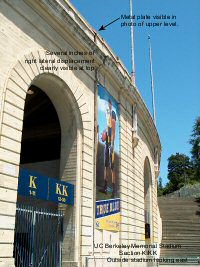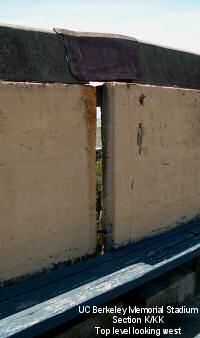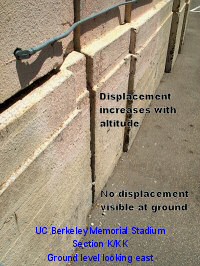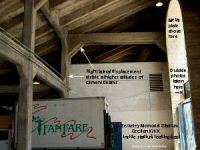Fault Creep at UC Berkeley Memorial Stadium.
Why is it visible at the top, but not where the stadium enters the ground?
UC Berkeley ("Cal") is one of the major stops on tours of the Hayward Fault in the San Francisco Bay Area. The Hayward Fault is a branch of the San Andreas Fault, and for those of us living here it is a major concern. For ten years I was lucky enough to have my office right on top of the fault, in the infamous "Section KK" at the stadium. Every April (anniversary month of the SF '06 earthquake), tours would come and see all the wonderful signs of creep. It's great: at the top the stadium wall has split about 30 cm. Several decades ago someone put a metal plate across the gap (see second photo on right).So, I moved on from my concessions work, received a degree in Physical Science (with emphasis on Earth Science) at Cal State Hayward (now named Cal State East Bay), and have been teaching high school science since 1993
I've always wondered:
Why do the
walls show no signs of
creep at the bottom, where I would expect to see the most motion?
A little background:
The motion of the Hayward Fault is "right lateral." This means if you look across the fault, the far side will appear to be moving to the right (it doesn't matter which side of the fault you're on--think about this). Thus, the west side is moving north relative to the east side. This is what the stadium shows at the top.Answers emailed from David A Schmidt
Most buildings respond to fault creep in complex ways, and Memorial
Stadium is no exception. While fault creep may be ocurring along a
discrete line beneath the stadium, structures tend to deform either where
the construction is the weakest or where segments meet. So while the
deformation may look localized in the structure, it is not required that
the fault trace is located directly below the cracking. For the south
side of the stadium, the fault trace is actually located just to the east
somehwere beneath the flight of cement stairs, although it is difficult to
see. The stadium has responded by deforming at the expansion gap in the
structure near the top of the seats. The deformation is not as clear on
the north side of the stadium because the closest expansion gap is 100
yards away. Our measurments from observing stations separated 100 yards
across the fault has shown that the west side of the stadium is moving
north at a rate of ~0.25 inch/year relative to the east side.
For a nice online tour of the Hayward Fault, visit http://www.mcs.csuhayward.edu/~shirschf/tour-1.html
Also, be sure to visit http://quake.usgs.gov/research/geology/hf_map/GE_helicopter.htm for a Google Earth virtual helicopter tour of the Hayward fault (it took me a while to find the "Play" button for the tour, so be sure to read the instructions on the web page).
All of the photos below
can be enlarged by
clicking on them.

Looking east from outside the
stadium.

Metal plate across displacement at top of wall.

Here's the mystery?
Why hasn't the ground moved?

Another view of the inside of the stadium showing displacement.